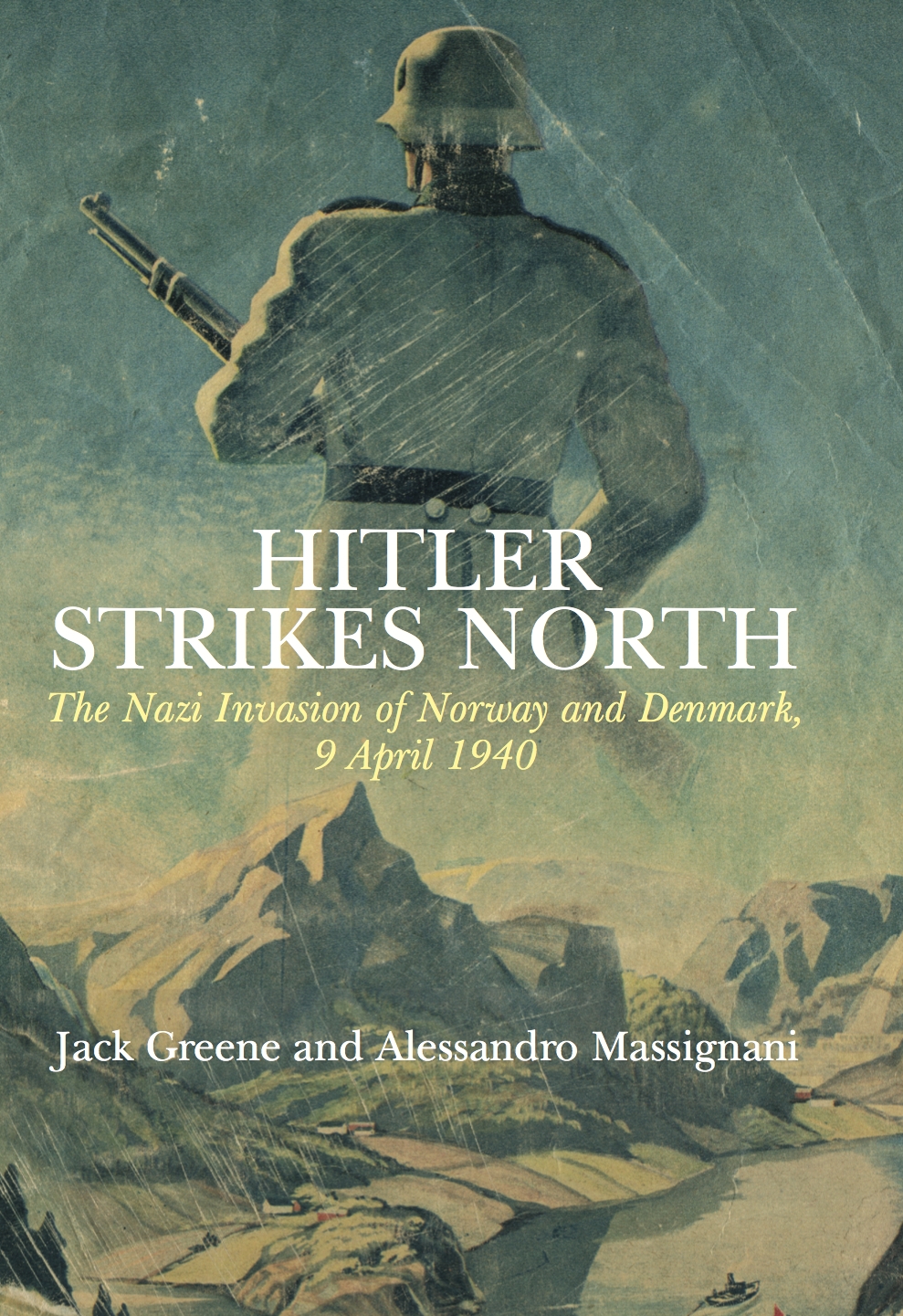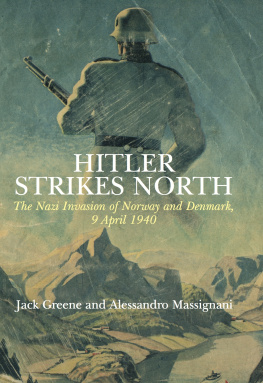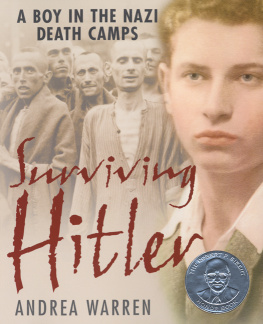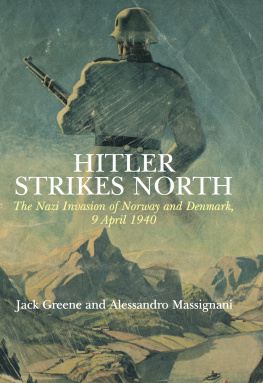Jack Greene - Hitler Strikes North
Here you can read online Jack Greene - Hitler Strikes North full text of the book (entire story) in english for free. Download pdf and epub, get meaning, cover and reviews about this ebook. year: 2013, publisher: Frontline Books, genre: History. Description of the work, (preface) as well as reviews are available. Best literature library LitArk.com created for fans of good reading and offers a wide selection of genres:
Romance novel
Science fiction
Adventure
Detective
Science
History
Home and family
Prose
Art
Politics
Computer
Non-fiction
Religion
Business
Children
Humor
Choose a favorite category and find really read worthwhile books. Enjoy immersion in the world of imagination, feel the emotions of the characters or learn something new for yourself, make an fascinating discovery.
- Book:Hitler Strikes North
- Author:
- Publisher:Frontline Books
- Genre:
- Year:2013
- Rating:4 / 5
- Favourites:Add to favourites
- Your mark:
- 80
- 1
- 2
- 3
- 4
- 5
Hitler Strikes North: summary, description and annotation
We offer to read an annotation, description, summary or preface (depends on what the author of the book "Hitler Strikes North" wrote himself). If you haven't found the necessary information about the book — write in the comments, we will try to find it.
Jack Greene: author's other books
Who wrote Hitler Strikes North? Find out the surname, the name of the author of the book and a list of all author's works by series.
Hitler Strikes North — read online for free the complete book (whole text) full work
Below is the text of the book, divided by pages. System saving the place of the last page read, allows you to conveniently read the book "Hitler Strikes North" online for free, without having to search again every time where you left off. Put a bookmark, and you can go to the page where you finished reading at any time.
Font size:
Interval:
Bookmark:

D anish army, Lieutenant General W. W. Prior commanding. The majority of the army was conscripted, but only a small percentage was inducted each year and training lasted for only a few weeks. In peacetime the Life Guards consisted of two battalions with a third battalion in reserveall tall volunteers. NOTE: this represents the mobilised army, but this was not the case on 9 April 1940. Only a very small portion of this order of battle was available on that day.
General Command (headquarters at Copenhagen)
air defence Regiment (minus the 13th and 14th AA Battalion)
Eleven artillery batteries (four horse, four light, three heavy)
Three motorised AA batteries (four guns each)
Engineer Regiment (minus 1st and 2nd Pioneer battalion)
Signal battalion
Sjaelland Division (headquarters at Copenhagen)
Life Guards Regiment
1st, 4th and 5th Infantry Regiments
- Four battalions each
- Five companies each
- (Attached) heavy weapons company
Guards Hussars Regiment ( Garde Hussar Regimentet )
- Two battalions, each with three squadronstwo horse-mounted and one bicycle but one horse-mounted company was to convert to Swedish supplied armoured cars just before the war
- Attached were one motorcycle squadron and one heavy weapons squadron
1st and 2nd artillery Regiments
- The 1st consisted of three battalions of twelve guns each. One battalion had motorised 75mm field guns and the other two were of 150mm guns which were scheduled to be motorised that summer. They were the heavy artillery of the Danish army and were attached to the division
- The 2nd had four battalions of three batteries each. Each battalion had two batteries of old Krupp 75mm and one of new French Schneider 105mm howitzers. They were in the process of having the 75mm guns replaced. A battery consisted of four guns
13th AA battalion (three batteries deployed at Copenhagen)
1st Pioneer battalion (four engineer companies)
Jylland Division (headquarters at Viborgnorthern Jutland)
2nd, 3rd, 6th, and 7th Infantry Regiments four battalions each
- The 6th had two battalions of bicycle troopsthe 4th and 5th. The former had been sent down to the border for training prior to the invasion, while the latter began to mobilise on the night of 8 April
Jylland Dragoon Regiment (two battalions, each with three squadronsone horse mounted and two bicycle, and one with three armoured cars. Six more were on order)
- Attached were one motorcycle squadron and one heavy weapons squadron
Pioneer Fodfoldsregimentet or Frontier Guards was attached to the Jutland Division and was the best-equipped and most motorised of any Danish unit. The two battalions consisted of one mortar and three machine-gun companies each.
3rd artillery Regiment (equipped similarly as the 2nd Artillery Regiment above)
14th motorised AA battalion of three batteries at rhus
2nd Pioneer Battalion (two engineer companies and an infantry pioneer unit of regimental strength with two battalions having a battalion HQ and four companies. Their primary duty was to lay mines on the Danish border)
Independent forces
10th AA Artillery Regiment (three batteries) assigned to Copenhagen
One battalion of Signal troops attached to the engineer regiment
Bornholm Guard for the defence of Bornholm Island. One under strength regiment, due to leave and lack of funding on 9 April; it had thirty men under arms. At full strength:
- Four battalions of infantry
- One bicycle squadron
- Four 75mm guns
- Heavy weapons company
The Danish army had tested a few armoured vehicles for evaluation purposes including the Italian Fiat 3000B, French Renault Nc2 (Nc.31) and British Vickers-Armstrong Carden-Loyd Patrol Mk.IV of 1931 design. The latter were light tanks armed with machine-guns and Denmark bought three but they were worn out by 1940. She had ordered eighteen Swedish Landsverk Lynx (L185) armoured cars but only three had arrived at the time of war and were assigned to the Jutland Division. One of those three was probably an earlier and similar model, but with lighter armour, a L181.
Motorcycles were of the Nimbus Model C, built in Copenhagen by Fisker & Nielsen. Thousands were produced after the war, while approximately 300 were used in Europe during the war. Denmark had experimented in the 1930s on an armoured Harley-davidson (which was too heavy and was a failure) but did arm some Nimbus motorcycles with a 20mm Madsen machine-gun which could not be used while the motorcycle was in motion.
When fully mobilised there were a reserve division, additional fortress troops and a minor home guard.
Danish Navy
Commanded by Vice Admiral Hjalmar Rechnitzer
at Frederikshavn and mobilised was the coastal defence ship Peder Skram (3,785
tons and launched in 1908). Also torpedo-boats Dragen , Hvalen and Laxen (290
tons and launched in 192930)
at rhus was the submarine tender Henrik Gerner and submarines Havfruen , Havmanden and Havkalen (320 tons and launched in 19378. A fourth would be completed after the invasion)
In Great Belt area there were 180 mines, Glenten and Hgen torpedo-boats (290 tons and launched in 1933), one minelayer, three minesweepers and five patrol craft
In Little Belt area were 264 mines, one patrol craft and one guardship
In Grnsund area were a few mines and two patrol craft
at Nyborg was the rnen torpedo-boat (290 tons and launched in 1934)
at Copenhagen was the flagship, the coastal defence ship Niels Iuel (4,100 tons and launched in 1918refitting). Also submarines Daphne and Dryaden (308 tons and launched in 19256) and Rota , Flora and Bellona (301 tons and launched in 191820), two minesweepers and two guardships
Elsewhere, including two patrol ships at Greenland, were seven patrol ships, two minelayers, one seaplane tender and one guardship
The German and Danish order of battles are included as the Allied and Norwegian ones are easily taken from Leo Niehorsters site and from Geirr Haarrs two volumes on the Norwegian campaign. The Danish, due to their short resistance, is difficult to come by and the German army order of battle is usually built upon incorrect assumptions. The Germans were not at full strength when they were committed to the Scandinavian campaign.
T he German forces sent to Norway were not Germanys finest. As has been noted, they were later wave divisions only recently raised and with little combat experience. Equipment was often lacking. Only two divisions were at full strength for their TO&E: the binary 3rd Mountain Division and the 69th Infantry Division. The 196th was particularly under-strength for support units. One recalls Secretary of defense donald Rumsfeld, who said, as you know, you go to war with the army you have. Theyre not the Army you might want or wish to have at a later time. Germanys divisions were missing their armoured car reconnaissance elements, so they relied on bicycle troops and some motorcycles, and most were short their full artillery complement.
A German infantry division in 1940 was based on 3 infantry regiments and 1 artillery regiment, a signals battalion, a recon battalion, an AT battalion, an engineer battalion and miscellaneous support elements. An infantry regiment had 3 battalions and 1 engineer company. Each battalion had 3 infantry companies (2 officers, 21 NCOs and 201 men) and 1 machine-gun company, which was made up of 1 mortar (6 3in mortars) and 3 platoons each with 4 sub-machine-guns, with a total of 77 men. The total strength of an infantry battalion was 820 officers and men. Each infantry company had 16 sub-machine-guns and 12 light machine-guns available; moreover, there were 3 AT rifles and 3 light 50mm mortars present.
Font size:
Interval:
Bookmark:
Similar books «Hitler Strikes North»
Look at similar books to Hitler Strikes North. We have selected literature similar in name and meaning in the hope of providing readers with more options to find new, interesting, not yet read works.
Discussion, reviews of the book Hitler Strikes North and just readers' own opinions. Leave your comments, write what you think about the work, its meaning or the main characters. Specify what exactly you liked and what you didn't like, and why you think so.






